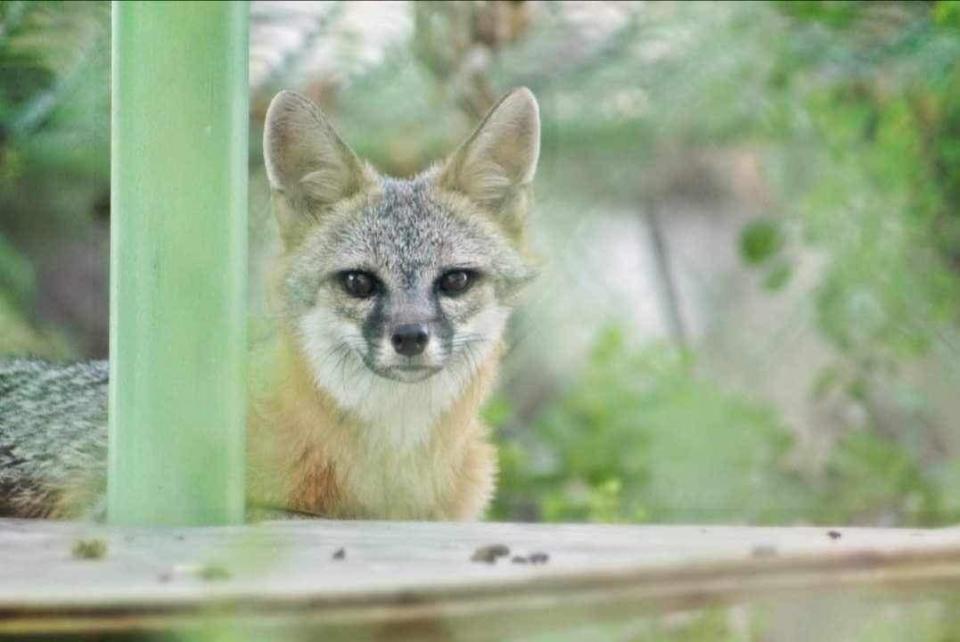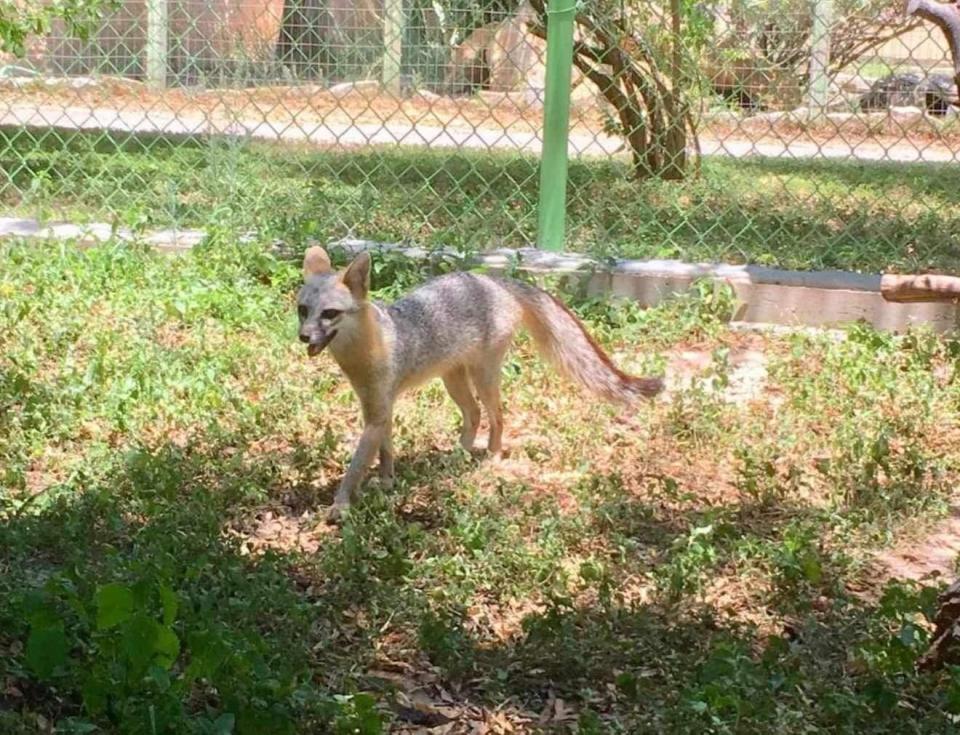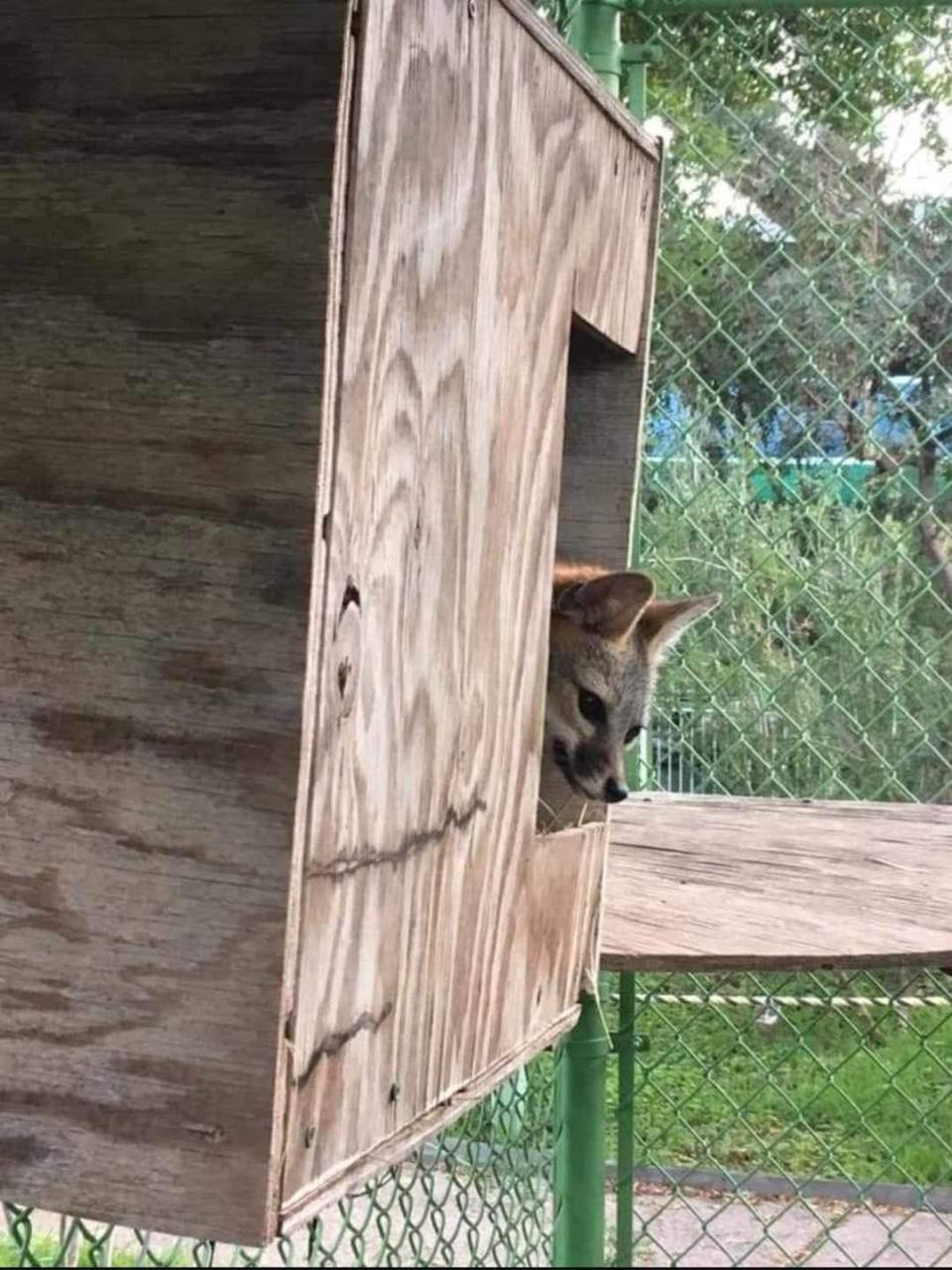Gray Fox survives in a hostile world
Our area’s smallest wild canid, the Common Gray Fox, competes with coyotes, raccoons, bobcats, and other predators for its living space and meals; but the Gray Fox succeeds and flourishes among these competitors with its own particular lifestyle and grace. Two of the Gray Fox’s common names (the Cat Fox and the Tree Fox) give us hints about the unique adaptations that help this canid survive in varied habitats across its range.

As its common name implies, these small foxes have distinctive, grizzled, salt-and-pepper gray fur over their back, sides, and tail. Tri-banded guard hairs are responsible for the salt-and-pepper colors; whereas, the legs, bottom of each side and tail, and backside of the ears are a striking orange to rust color. The neck, belly, fur inside the ears, and parts of the face are marked with white fur. Ears are upright and pointed and the nose pad is relatively narrow and black. A prominent black stripe (sometimes referred to as a mane) extends down the middle of the back and bushy tail and ends with a black-tipped tail. Gray foxes are approximately the size of small terrier dogs.

The Gray Fox is found in suitable habitats throughout North Central Texas and Southwestern Oklahoma and, although this fox is most successful in woodlands, pasturelands, and riparian areas along streams and rivers, it has adapted well to edge habitats and borders between pastures and open fields, and even the outskirts of suburban and urban areas. The presence of trees within these habitats help the fox survive and compete against potential predators such as coyotes, badgers, and even domestic dogs in urban settings.

Gray foxes are unique among canids in their ability to climb trees to seek refuge and also to search for additional food sources in an arboreal setting. The claws of gray foxes are semi-retractable and rather broad and curved; thus allowing for a more secure grip on tree trunks. Also, gray foxes can rotate their forelimbs and wrists more than other canids and these adaptations allow the foxes to climb trees in a fashion similar to cats (by hanging onto the tree trunk by its forelegs and pushing itself upward with the hindlegs). The foxes descend by backing down the trees and/or running down head-first if the tree trunk is appropriately slanted. Gray foxes also travel along branches and will jump from branch to branch within and between trees; although they are not as agile in arboreal environments as cats.

The Gray Fox’s diet varies according to season and, similar to other species of canids, they are opportunistic omnivores. During the winter months, gray foxes depend upon various species of rodents (such as deer mice, white-footed mice, pocket mice, kangaroo rats, woodrats, and cottonrats) and cottontail rabbits for a large percentage of their total diet. In addition to these staple prey items, increased amounts of plant matter (such as acorns, hackberries, prickly pear fruits, and wild grapes) and insects (including grasshoppers and crickets), are consumed whenever available. Because of their ability to climb and forage in trees, gray foxes also consume squirrels, birds, and bird eggs. Researchers have noted that gray foxes seem to have a preference for Mourning Doves and American Robins but will/can also capture and consume other passerine and ground nesting bird species. Gray foxes also consume carrion and will utilize edible, human-generated refuse whenever residing in suburban and urban areas. If a surplus of food is obtained or located, a gray fox may cache the surplus food by burying it and marking the spot with urine and/or anal gland secretions.

Predators of gray foxes include hawks, owls, bobcats, and coyotes. The Gray Fox is also sought by humans for its strikingly colored pelt/fur. In locations where coyotes and gray foxes co-occur, coyotes will kill (but not consume) gray foxes if these two canids encounter each other and the fox(es) cannot escape. The aggressive behavior of coyotes is believed to be the result of interspecific competition with gray foxes for resources within their immediate environment. Competition is somewhat reduced by the Gray Fox’s arboreal resting, denning, and foraging abilities/behaviors and the coyote’s abilities to successfully forage in more open areas. However, a great deal of dietary overlap still exists between both species and both tend to be most active during crepuscular (dawn and dusk) and nighttime hours. Few intensive studies have been conducted on resource competition between coyotes and gray foxes; but it appears that, where they occur together, coyotes consume more carrion items and gray foxes eat larger percentages of fruits and insects and a relatively consistent (albeit rather small) percentage of birds throughout the year. Coyotes seem to be more opportunistic predators of birds and may frighten the foxes away from carrion. Even though the differences seem slight, resource partitioning and foraging strategies such as these allow coexistence between the two canids in many locations.

More: Clever coyotes may be victims of their own success
Adult gray foxes are monogamous and usually mate between the months of December to March. Gestation, or pregnancy, length is approximately two months and results in an average litter of four young foxes, which are referred to as kits or pups. Natal dens may be located in brush piles, rocky crevices, abandonded dens of other animals or constructed/dug by the male and female partners, or in hollow trees and/or stumps. Interestingly, newborn kits are a uniform brownish-gray color. Although the male parent hunts for his mate as she prepares the natal den, both parents hunt separately after the kits are born. The young foxes begin hunting with their parents when reaching approximately four months of age and usually begin dispersing when attaining maturity in 10 months. Gray foxes communicate with each other through a series of barks, yips and yaps, growls, squeals, and chuckles.
Our area’s gray foxes may be small in size but, because of their adaptations and lifestyle, these little canids can “hang with the big dogs!” Although they are most active during crepuscular and nocturnal hours, you may also encounter one during daylight hours as the fox travels along trails and roadsides located at the margins of pasturelands and within wooded and/or rocky areas. Also, remember to look upward into the trees and you may be rewarded with the site of this attractive, arboreal Tree Fox.
Jim Goetze is a retired professor of biology and former chairperson of the Natural Sciences Department of Laredo College with an avid interest in all aspects of the natural world. He can be contacted at gonorthtxnature@gmail.com
This article originally appeared on Wichita Falls Times Record News: Gray Fox survives in a hostile world

